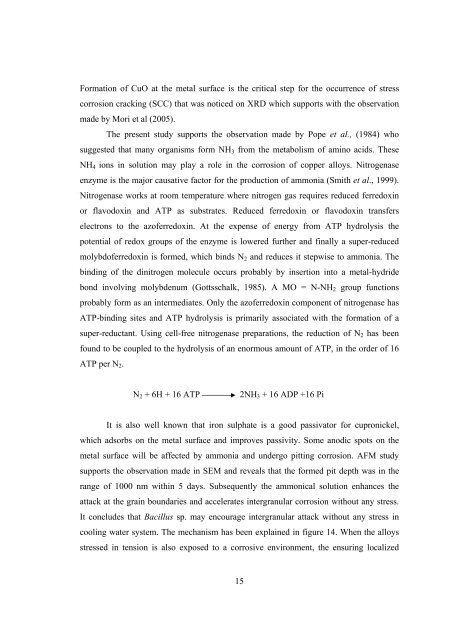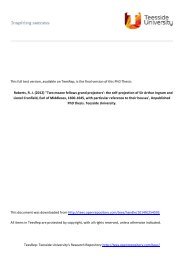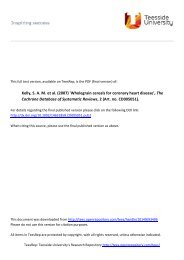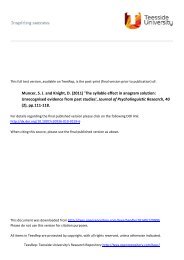Maruthamuthu, S. et al. - Teesside's Research Repository
Maruthamuthu, S. et al. - Teesside's Research Repository
Maruthamuthu, S. et al. - Teesside's Research Repository
You also want an ePaper? Increase the reach of your titles
YUMPU automatically turns print PDFs into web optimized ePapers that Google loves.
Formation of CuO at the m<strong>et</strong><strong>al</strong> surface is the critic<strong>al</strong> step for the occurrence of stress<br />
corrosion cracking (SCC) that was noticed on XRD which supports with the observation<br />
made by Mori <strong>et</strong> <strong>al</strong> (2005).<br />
The present study supports the observation made by Pope <strong>et</strong> <strong>al</strong>., (1984) who<br />
suggested that many organisms form NH3 from the m<strong>et</strong>abolism of amino acids. These<br />
NH4 ions in solution may play a role in the corrosion of copper <strong>al</strong>loys. Nitrogenase<br />
enzyme is the major causative factor for the production of ammonia (Smith <strong>et</strong> <strong>al</strong>., 1999).<br />
Nitrogenase works at room temperature where nitrogen gas requires reduced ferredoxin<br />
or flavodoxin and ATP as substrates. Reduced ferredoxin or flavodoxin transfers<br />
electrons to the azoferredoxin. At the expense of energy from ATP hydrolysis the<br />
potenti<strong>al</strong> of redox groups of the enzyme is lowered further and fin<strong>al</strong>ly a super-reduced<br />
molybdoferredoxin is formed, which binds N2 and reduces it stepwise to ammonia. The<br />
binding of the dinitrogen molecule occurs probably by insertion into a m<strong>et</strong><strong>al</strong>-hydride<br />
bond involving molybdenum (Gottssch<strong>al</strong>k, 1985). A MO = N-NH2 group functions<br />
probably form as an intermediates. Only the azoferredoxin component of nitrogenase has<br />
ATP-binding sites and ATP hydrolysis is primarily associated with the formation of a<br />
super-reductant. Using cell-free nitrogenase preparations, the reduction of N2 has been<br />
found to be coupled to the hydrolysis of an enormous amount of ATP, in the order of 16<br />
ATP per N2.<br />
N2 + 6H + 16 ATP 2NH3 + 16 ADP +16 Pi<br />
It is <strong>al</strong>so well known that iron sulphate is a good passivator for cupronickel,<br />
which adsorbs on the m<strong>et</strong><strong>al</strong> surface and improves passivity. Some anodic spots on the<br />
m<strong>et</strong><strong>al</strong> surface will be affected by ammonia and undergo pitting corrosion. AFM study<br />
supports the observation made in SEM and reve<strong>al</strong>s that the formed pit depth was in the<br />
range of 1000 nm within 5 days. Subsequently the ammonic<strong>al</strong> solution enhances the<br />
attack at the grain boundaries and accelerates intergranular corrosion without any stress.<br />
It concludes that Bacillus sp. may encourage intergranular attack without any stress in<br />
cooling water system. The mechanism has been explained in figure 14. When the <strong>al</strong>loys<br />
stressed in tension is <strong>al</strong>so exposed to a corrosive environment, the ensuring loc<strong>al</strong>ized<br />
15





